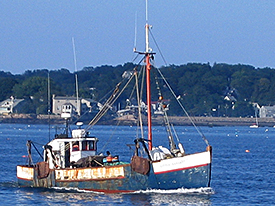
Built in 1946, the Little Sandra is one of the last eastern rig draggers still actively fishing the Stellwagen Bank National Marine Sanctuary's waters as a side trawler (courtesy of NOAA/SBNMS).
The introduction of the internal combustion engine and the otter trawl at the beginning of the 20th century radically changed the face of New England's fishing fleet. This change in fishing technology is exemplified in a vessel known as an eastern rig dragger. The eastern rig dragger proved to be so productive and profitable that between 1940 and 1970 it dominated New England's fishing fleet. Historical records indicate that over 500 eastern rig draggers were built and/or operated in New England. As a result of the sheer number of vessels on the water and their efficiency a number of key Gulf of Maine species, such as flounder, cod, haddock, pollock, and redfish, were caught in record numbers.
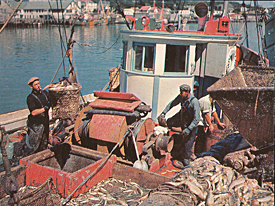
Unloading a day’s catch in Gloucester, MA (courtesy of Deborah Marx).
The eastern rig dragger is a wooden-hulled engine-powered fishing vessel that deployed, towed, and recovered its otter trawl net or dredge over the vessel's side as opposed to over the stern as done in modern stern trawlers. Reflecting its schooner ancestors, eastern rig draggers had an aft positioned wheelhouse that contained the helm and the captain’s bunk. Below decks, eastern rig draggers were divided into thirds by bulkheads with the crew’s quarters and galley in the forecastle, fish hold amidships, and aftermost compartment holding the engine and engineer’s quarters. The vessel’s distinctive fishing gear consisted of a single heavy drum winch positioned in front of the wheel house spooled with wire rope and equipped with one or more gypsy heads for net handling. Inverted horseshoe-shaped gallows frames were positioned in pairs along the vessel’s side and supported the tension of the towed fishing gear. During the gear’s recovery and deployment, the gallows frames supported the weight of the otter trawl doors.
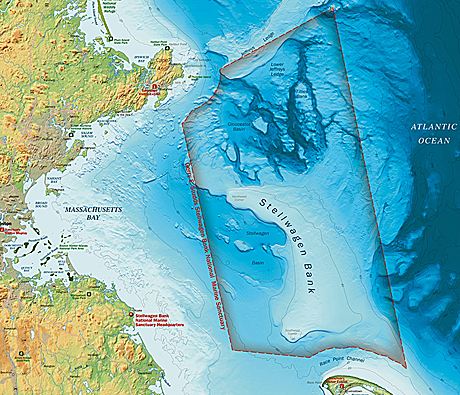
A concentration of historic eastern rig dragger shipwrecks have been found in NOAA’s Stellwagen Bank National Marine Sanctuary off Massachusetts (courtesy of NOAA/SBNMS). (Large View ).
The evolution of New England's fishing fleet exemplified by the eastern rig dragger began in the 1920s. During the first decade of the twentieth century, otter trawling arrived from Great Britain in the form of the steam trawler. At the same time, schooners were outfitted with internal combustion engines to support seining and movement on the fishing grounds. By the 1920s, enterprising fishermen combined the fishing efficiency of the otter trawl net with the affordability of diesel propulsion in schooner-style hulls. Many dory-trawling schooners were converted to eastern rig draggers, while other fishermen had vessels purpose-built. Maine's skilled wooden boat builders produced many vessels, but others were built up and down the eastern seaboard.
Over the next fifty years, the demands of otter trawling refined the eastern rig dragger. Improvements in diesel engines, fish finding and communications electronics, and synthetic net materials led to vessels better suited to fishing year-round in stormy New England weather and over rougher terrain. Ultimately, the eastern rig dragger's basic design feature, setting its net over the side, led to its diminishment during the 1970s when trawling methods changed from handling the net from the side to off the stern. This vessel design was known as a "western rig dragger" with a forward wheelhouse, stern ramp, and net reel placed at the stern to facilitate safer and more economical fishing.
This slideshow presents images of the eastern rig draggers Joffre and Edna G. while in service and in their present condition at the bottom of the Atlantic.
Due to its proximity to some of New England’s most prolific fishing ports, the Stellwagen Bank National Marine Sanctuary holds a concentration of historic eastern rig dragger shipwrecks. The Stellwagen Bank National Marine Sanctuary (SBNMS) is one of 14 National Marine Sanctuaries and Marine National Monuments managed by National Oceanic and Atmospheric Administration’s (NOAA) Office of National Marine Sanctuaries. Historical records indicate that over fifty eastern rig draggers sank in what is now the sanctuary. These vessels were lost between 1930 and 2003 and their shipwrecks represent over seventy years of fishing heritage. In addition to eastern rig draggers originally built as schooners, others were converted from World War I submarine chasers, Word War II minesweepers, and even steam yachts. Archaeologists have so far located eight eastern rig dragger shipwrecks that were built in shipyards ranging from North Carolina to Maine. Two of those vessels, the Joffre and the Edna G., are listed on the National Register of Historic Places and both are located off Gloucester, MA in over 300 feet of water.
NOAA archaeologists located the remains of the 105-foot long eastern rig dragger Joffre and used a remotely operated vehicle (ROV) to document its remains. The shipwreck consists of its wooden lower hull, vessel fittings, diesel engine, and fishing gear such as the trawl winch and gallows frames. The study of the Joffre is ongoing and analysis of the vessel’s remains will provide information about shipboard life, the vessel’s adaptation from a dory trawling schooner to eastern rig dragger, and finally its wrecking event.
Designed by renowned naval architect Thomas F. McManus, Arthur D. Story of Essex, MA launched the Joffre as an auxiliary fishing schooner in 1918. The Joffre was the older sister ship of the L. A. Dunton now held in the collections of Mystic Seaport. Initially, Joffre entered the mackerel seine fishery, but within a year, its owners set the schooner dory trawling after halibut and haddock. The vessel set records for single trip landings of these fish varieties in the 1920s. In 1939, Joffre’s new captain, Simon Theriault, converted the vessel into an eastern rig dragger to pursue Acadian redfish, a rapidly developing fishery. The Joffre landed tremendous quantities of redfish; one year it caught 1.2 million pounds of that fish variety alone.
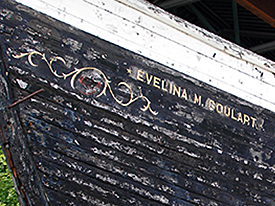
The Evelina M. Goulart was acquired by the Essex Shipbuilding Museum in 1990 (courtesy of Deborah Marx). (Large View ).
Joffre entered the archaeological records as it returned from a routine ten-day fishing trip to Nova Scotia’s offshore banks. Not far from its home port of Gloucester, MA, the Joffre’s engine caught fire on the evening of 9 August 1947. The fire quickly engulfed the vessel forcing the ten-man crew to abandon ship into dories. Despite efforts to quench the blaze and tow the vessel to port, the Joffre sank the next morning. During its 29 year career it landed over 15 million pounds of fish.
The eastern rig dragger Edna G. has also been located in SBNMS and surveyed with an ROV to record its remains. Investigating the Edna G. shipwreck sheds light on a rapidly disappearing watercraft variety emblematic of New England’s fishing heritage. Its wooden hull lies upright on the seafloor with its pilothouse and trawl winch still intact and in place.
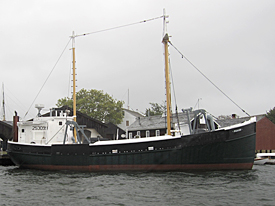
The Mystic Seaport’s eastern rig dragger Roann was re-launched after a major restoration project (courtesy of NOAA/SBNMS). (Large View )
The Morehead City Shipbuilding Corporation of Morehead City, NC built the 54-foot long Edna G. in 1956 specifically for the New England groundfish fleet. For the first 16 years of its career the vessel stayed in southern water fishing for flounder and croaker out of Vandemere, NC. In 1972, it was sold North and moved up to Portland, ME and then to Gloucester, MA in 1977 where it remained until its loss in 1988. On 30 June 1988 Edna G.’s crew heard a strange noise in the engine room while they were deploying its trawl net. When they went below, they found the engine room filling with water. Thirty minutes later the dragger sank leaving the two men afloat in a dory. The cause of the sinking was never determined.
Eastern Rig Draggers in the Stellwagen Bank National Marine Sanctuary.
Today, approximately a dozen of more than 500 eastern rig draggers built are still actively fishing or afloat. These vessels are slowly disappearing as they sink or are scrapped. Currently, the Evelina M. Goulart at the Essex Shipbuilding Museum and the Roann at Mystic Seaport are the only eastern rig draggers held in museum collections as historic ships. The 83-foot long Evelina M. Goulart was built in 1927 as an auxiliary schooner and later converted into an eastern rig dragger for groundfishing. The Essex Shipbuilding Museum acquired the Evelina M. Goulart in 1990 and displays it un-restored in a covered shed near to where it was launched. In 1997 Mystic Seaport acquired the 60-foot long Roann originally launched in 1944. Seaport shipwrights have rebuilt and restored the vessel so that it may become a floating classroom for the interpretation of New England’s fishing heritage.
For more information visit:
Stellwagen Bank National Marine Sanctuary
http://stellwagen.noaa.gov
Office of National Marine Sanctuaries
http://sanctuaries.noaa.gov
Mystic Seaport
http://www.mysticseaport.org/
Essex Shipbuilding Museum
http://www.essexshipbuildingmuseum.org/
About the Author: Deborah Marx is a maritime archaeologist with NOAA’s Stellwagen Bank National Marine Sanctuary in Scituate, MA. She is a graduate of East Carolina University’s Program in Maritime Studies.
Comments, suggestions, and questions can be directed to Deborah.Marx@noaa.gov
Return to In The Field home page.
Comments, suggestions, or questions can be directed to research@themua.org




